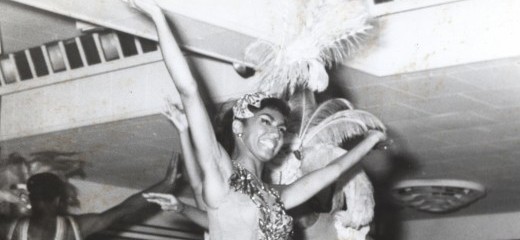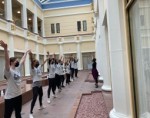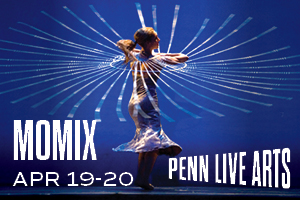
Photo: Joan Myers Brown, private collection
Brown’s “Audacious Hope”: A Book Review
By Ellen Gerdes
“To be a black ballerina in twentieth century America was the artistic equivalent of staging a civil rights protest.” With this statement, Brenda Dixon Gottschild introduces
Joan Myers Brown and the Audacious Hope of the Black Ballerina: A Biohistory of American Performance. Biography here is integrated with an American dance history of racial exclusion and a Philadelphia history that has shaped the Philadanco aesthetic. In a collage of interviews, recital programs, and historical analysis, Gottschild begins by looking at the earliest black Philadelphia dancing schools (in the 1920s and ’30s) headed by pioneers Sydney King, Marion Cuyjet, and Essie Marie Dorsey.
Drawing from W.E.B. Dubois’s The Philadelphia Negro, which exposed the social stratification of blacks in Philadelphia, Gottschild asserts that ballet represented a European ideal and the kind of approval from the white world sought by the black bourgeoisie. Cotillion balls in the black elite communities often showcased full-length narrative ballets.
Gottschild tells the story of both discrimination against and perseverance of black dance pioneers in the 1940s and ’50s. Cuyjet, who was often assumed to be white, was kicked out of the Littlefield Ballet after her friends inadvertently outed her by coming backstage to congratulate her. Joan Myers Brown, inspired by her high school gym teacher, learned ballet at school from her friends who taught her what they had learned in all-white dance studios. She was the first black dancer (followed by Judith Jamison) admitted to Antony Tudor’s Ballet Guild in Philadelphia in 1951 (pre-Pennsylvania Ballet). Tudor advised Brown to leave Philadelphia to dance professionally; at the time, black dancers had more success joining established ballet companies in Europe than in the U.S.
Brown toured instead in black vaudeville shows, often for all-white audiences. In 1967, she performed as one of Club Harlem’s “Beige Beauts.” One of this book’s many archival photographs is of a young Brown posing with Sammy Davis, Jr., in feathered costume and pointe shoes backstage in Atlantic City. Ultimately, she grew tired of the touring lifestyle; she founded her dance school in 1960 and Philadanco in 1970. She decided to “train kids so somebody can get the opportunity I didn’t.” Persistent, capable, and stern, Brown was also resourceful. She recruited football players from West Philadelphia High School as the first male Philadanco dancers.
Gottschild astutely teases out Brown’s artistic background in relation to Philadanco. Although considered a modern dance company, Philadanco’s standard of beauty and presentation of gender roles often reflect classical ballet values. Gottschild views Brown’s desire to entertain her audience—“Show biz meets postmodernsim”—as an extension of her showgirl days. Both positive and negative reviews of Philadanco reveal what Gottschild considers the “Philadelphia aesthetic”: a particular energy, attitude, southern/small-town etiquette, and work ethic typical of black communities. She includes current local favorites Bobby Zankel, Makoto Hirano, and Germaine Ingram as participants in this aesthetic. Notably, they are not all black artists.
In the last chapter, “Audacious Hope: The House that Joan Built—1980s–Twenty-First Century,” Gottschild borrows from President Obama’s March 4, 2007 speech in Selma, Alabama, titled “The Joshua Generation.” He spoke of members of the “Moses generation” as those who led the civil rights movement; Gottschild includes Tally Beatty, Harold Pierson, Pearl Primus, Louis Johnson, and Joan Myers Brown in this group. She writes, “the black Moses artists had to deal with American racial discrimination and segregation on top of every other obstacle.... Joshua choreographers who came of age after the civil rights era are securely situated in the Promised Land, imperfect though it may be.” The chapter highlights the experiences of Philadanco dancers, delving into contemporary race issues.
Kim Bears-Bailey, assistant artistic director for Philadanco, shares her struggle transferring Strange Fruit (first choreographed by Pearl Primus in 1944–45) onto her body for the American Dance Festival in 1988.: “Strange Fruit is based on a lynching, someone witnessing a lynching, and I’m going, ‘This is out of my league. I’ve only read about it, I don’t know. I’d never witnessed it.’” Bears-Bailey, of the Joshua generation, experienced less overt forms of racism; she recounts feeling invisible as the only black ballet major in her class in the 1980s at the University of the Arts (where she is now an associate professor). She bemoans the fact that funders might be more invested in diversity in theory than in practice. Gottschild uncovers the tendency of funders and critics alike to compare Philadanco to other predominantly black companies, relegating them to a separate set of funding structures and performance standards.
Gottschild weaves voices of dancers and dance teachers into the book, rendering the history both salient and personal. The details of Philadelphia dance schools, companies, and even addresses are fun to read: “Hey I know where that is!” At the same time, learning of the harsh reality of our city’s dance history reminds me of the work – in dance, in this city, in the United States – that we have yet to do.
I remember the night President Obama won the 2008 election. At the time, I lived near the Kimmel Center, so I took to Broad Street upon his victory. In a swarm of bodies and honking cars, young people screamed at the top of our lungs and paraded around City Hall. I remember a young African American man who looked at me and yelled, “My president is black!” And I yelled back, “Mine too!” We were both overjoyed, imagining an American future of opportunity for men like him. Yet in 2007, Gia Kourlas asked, “Where Are All the Black Swans” (
New York Times) in major U.S. companies (
http://www.nytimes.com/2007/05/06/arts/dance/06kour.html?pagewanted=all)
Data compiled by Doug Risner in 2009 shows African American participation in undergraduate dance programs at only 10%, while white participation is at 72 % (Higher Education Arts Data Services 2009).
Gottschild’s book demands that we consider exclusionary practices in dance. Who has opportunities for dance lessons as a child? Who has access to a dance teacher who reflects her or his students’ identity or cultural background? What bodies make it to the professional stage? What forms of dance are seen as legitimate study or art? I believe it is the responsibility of all of us, not just the black ballerina, to wrestle with these questions.
By Ellen Gerdes
October 10, 2012







.png)


